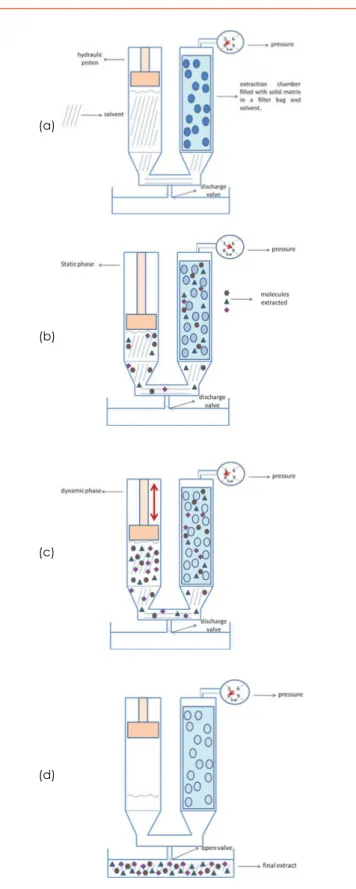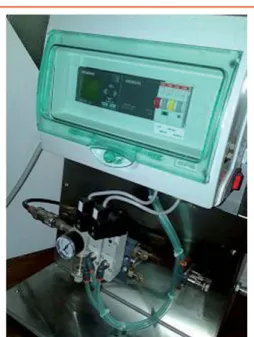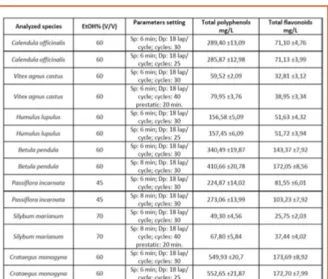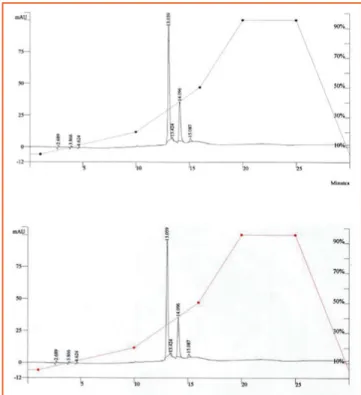KEYWORDS: polyphenols, phytotherapy, medicinal plants, estrattore naviglio®
Abstract
The role of polyphenols in human health nowadays is well established and these natural products, found in many plant species, are the active ingredients of drugs, food supplements and cosmetics. Extraction procedure is pivotal to obtain high quality herbal products but paradoxically this factor is often underrated and obsolete techniques are used. In this work we compared the classic and most used method of maceration and an innovative and standardized technique of extraction, Estrattore Naviglio®, processing ten common medicinal plants containing polyphenols and for each analysing specific biological markers such as flavonoids, anthocyanosides and caffeic derivatives in addition to total polyphenols content. Estrattore Naviglio® guaranteed a significant improvement of the chemical quality of extracts combining effectiveness with rapidity and reproducibility. In this work we further investigated the optimization of drug extractions by replicating operations varying parameters setting on Estrattore Naviglio® instrument.Optimization of extraction
of drugs containing polyphenols
using an innovative technique
INTRODUCTION
Polyphenols are a large class of active principles of many medicinal plants, chemically defined with a common moiety of an aromatic ring with one or more hydroxyl substituents (1). Polyphenols are secondary metabolites biogenetically originated from the shikimic acid pathway; they are divided in different classes and the most important, in phytotherapy, is that of the flavonoids which are divided in turn in sub-classes of molecules chemically distinct like, for example flavones, flavanones, catechins and anthocyanins (2). Polyphenols, to date, represent the most studied class of natural compounds and their role in human health is well established. Recent reviews highlight the correlation between the consumption of polyphenols through diet and maintaining of cognitive function (3), cardiovascular risk reduction (4) and gastrointestinal health (5). Many recent clinical findings also underline that polyphenols protect against
neurodegenerative disorders (6) and an inverse correlation between intake of diet polyphenols and onset of cancer was demonstrated (7). The mechanism of action of polyphenol in vivo vary depending on biological target: for example cardiovascular protection is primarily due to antioxidant and antiradical properties of these compounds (8) while their anti-aging effect depends on genes modulation as in the case of deacetylation of sirtuins (9). Polyphenols are the active ingredients of many plant species used in as drugs, nutraceutical and cosmetic; their content, like in general the content of active principles in herbal preparations, is dependent in primis on the quality of raw materials, their conservation and on the extraction processes of the drug. In different market sectors over than pharmaceutical, primarily the food supplement and cosmetic sectors, EFSA
(European Food Supplement Agency) in Europe, FDA (Food and Drug Administration) in USA and community and national regulations ensure the safe use of herbal preparations, but not necessary they guarantee chemical quality, a well-defined composition of products and reproducibility that are paramount factors that influence biologic properties (10). In this work our group investigated the possible optimization of extraction of polyphenols containing drugs. Depending on variable vegetal material features, such as drug’s physical properties,
phytocomplex stability, different methods of extraction are used; the most used techniques are percolation, maceration, Soxhlet extraction (11), ultrasound-assisted extraction (12) and extraction with supercritical fluids (13). Each of these techniques presents disadvantages in the extraction of polyphenols: long time of extraction (percolation and maceration), use of high temperature (Soxhlet), excessive selectivity of extraction (supercritical fluids), scarce yield in extracting matrix with dispersed phase (ultrasound) (14). The technique of Estrattore Naviglio®, known in Italy since
over 10 years (15), in the last years earned a prominent role in university research (16) and began to be used in industry thanks to machines with high capacity (up to 40 L) and high automation. Combining a high pressured and fully automated close system with a thermostatically controlled temperature, this innovative technique adequately responds to the needs of extraction of polyphenols containing drugs and it is developed precisely to overcome issues related with the classic extraction techniques and to drastically shorten extraction time. Extraction procedure includes a static phase under high pressure conditions (7,5/8 bar) followed by solvent recirculation (dynamic phase) supplied by a hydraulic pump; by varying the parameters of static phase time, dynamic phase and number of complete cycles, it is possible to
FOOD
TECHNOLOGIES
MARCO BIAGI*, DANIELA MANCA, BARBARA BARLOZZINI, ELISABETTA MIRALDI, DANIELA GIACHETTI *Corresponding author Unit of Pharmaceutical Biology, Department of Environmental, Earth and Physical Sciences,
University of Siena, Via Laterina 8, 53100 Siena, Italy
optimize extraction for each specific drug. A full description of the instrument, of Naviglio’s principle and operating details are reported below. In this work a comparison between Estrattore Naviglio® and maceration techniques was performed using ten of
the most common polyphenols containing drugs enlisted in the community monographs of Herbal Medicinal Products
Committee (HMPC) of the European Medicines Agency (EMA) or in European Pharmacopoeia 8th ed. and also used in cosmetic
and as food supplements. To quantify polyphenols, flavonoids, caffeic derivatives and anthocyanosides in extracts,
spectrophotometric methods and HPLC-DAD were used. In this work we also considered the optimization of extraction
parameters with the technique of Estrattore Naviglio®, by varying
instrument parameters.
NAVIGLIO’S PRINCIPLE AND ESTRATTORE NAVIGLIO®
Naviglio’s principle states that “the generation of a negative pressure gradient, using a suitable solvent, between the outside and inside of a solid matrix containing the material to be extracted, followed by a sudden reinstatement of the initial balanced conditions, leads to the forced extraction of those compounds that are not chemically linked to the main structure making up the solid” (15). Estrattore Naviglio® was first invented by
Prof. Daniele Naviglio in early ’90s of the past century in University of Naples, Italy, and developed to be, nowadays, versatile, robust and fully automated. The extraction procedure is conducted through the following stages of a cycle: a) Extraction chamber is filled with solid matrix contained in a filter bag and extraction solvent; b) System is closed and solvent compression start; c) Maximum system compression and start of static step; d) End of static stage and start of dynamic step; e) Pressure balance reached between outside solvent and that contained inside the matrix. Extraction cycles are replicated and finally extract is discharged. Figure 1 schematize the principle of operation of instrument. Figure 2 shows the front view of the instrument used in this work, Figure 3 shows the rear view where is visible the control panel of the instrument.
EXPERIMENTAL PART Materials and methods
Hops cones (Humulus lupulus L.), passionflowers flowerings tops (Passiflora incarnata L.), lemon balm leaves (Melissa officinalis L.), birch leaves (Betula pendula Roth.), calendula flowers
(Calendula officinalis L.), hawthorn leaves and flowers (Crataegus monogyna Jacq.), milk thistle fruits (Silybum
marianum L. (Gaertn)), echinacea root (Echinacea angustifolia
Moench.), chaste tree fruits (Vitex agnus-castus L.), bilberry fruits (Vaccinium myrtillus L.), all in herbal tea cut, were kindly provided by Erba Vita Italia, Monte Grimano Terme, Italy. A 500 cc glass becker and a 500 cc Estrattore Naviglio® machine
made by ATLAS Filtri, Padova, Italy, were used for extractions. The solvent used and the analytical standard were bought by Sigma-Aldrich, Milano. The water used for all analysis was produced with a Millipore Milli-DITM apparatus. Extracts were
prepared as described below and according to the scheme shown in table 1 using a mixture of water and ethanol. Total polyphenols in the extracts were determined by the colorimetric method of Folin-Ciocolteau (FC). 100 μl of each extract were added in 2900 μl of water and 500 μl of FC reactive. After 30 seconds of vigorous shaking 1000 μl of aqueous solution of
Figure 1. Scheme of working stages of extraction of solid matrixes by means of Estrattore Naviglio®: grinded herbal material or other solid matrixes are placed into an appropriate filter bag and located in the extraction chamber of the instrument filled up with solvent (a). The static phase under high pressure conditions (b) is followed by a dynamic stage produced by repeated sudden vertical movements of piston, which reduce the pressure (c): extraction from the solid matrix occurs, made possible by a difference in pressure generated between the inside and outside of the sample (Naviglio’s Principle). After an adequate number of extraction cycles, discharge valve is opened and extract collected (d).
(a)
(b)
(c)
instrument coupled to a photodiode array detector DAD; the column used for the analysis was a Varian Polaris C, RP18 (15 cm x 2 mm, 3 mm). The chromatographic separation was obtained using as mobile phase water/acetic acid (99:1) and acetonitrile (MeCN). The volume of elution was 10 μl, the flux was regulated at 0,25 l/min, and optical density was recorded at 330 nm (caffeic derivatives, chlorogenic acid as standard) and 520 nm (anthocyanosides, cyanidin-3-glucoside as standard) (16).
Extracts preparation
For classical method of maceration 50 g of each drug were extracted for 3 days with 500 ml of water and ethanol mixtures (table 1), constantly stirring with a magnetic stir bar. Ethanol percentage was chosen after previous investigations which indicated the best extracting mixture for polyphenols. After the maceration, drugs were pressed, extracts filtered and recovered and adjusted for a final drug:extract ratio 1:10. For the extraction with Estrattore Naviglio®, each sample was weighed and
transferred in a 50 μm extraction bag up to complete filling. The bag was placed in the extraction room that was filled with solvent of extraction and then hermetically closed. Static phase time and dynamic phase laps for each cycle of extraction and number of cycles of extraction were set on instrument as described in table 2, according to the standard extraction procedure of the instruments. Extractions were conducted at room temperature. At the end of extraction procedure, as for maceration, extracts were adjusted for a final drug:extract ratio 1:10. Extraction procedures with Estrattore Naviglio® were
subsequently replicated by varying all instrument parameters in order to optimize times and polyphenols yields. All the parameters of extractions are reported in table 3.
RESULTS
Influence of extraction parameters
Extractions with parameters different from the these standard underlined the need to increase the overall extraction time for all the drugs with the exception of whitethorn, hop and calendula, whose extracts showed similar concentrations of total polyphenols and flavonoids with short and long procedures. The increasing of times of solvent recirculation, in the dynamic phase of extractive cycles, didn’t determine significant change of polyphenols content in the extracts, while the increase of static phase time improved the yield of active constituents in the extraction of passionflower, lemon balm, bilberry and birch. A substantial improvement in the extraction of echinacea was achieved only with 8 minutes of static phase for each cycle and increasing the number of cycle respect to the standard procedure. Adding an ulterior initial pre-static phase appeared to be required for the extraction of total polyphenols of milk thistle and chasteberry since this solution allowed to soak completely the drug at the beginning of the extraction; the optimized extraction of milk thistle and chasteberry lasted 7 hours and 40 minutes. The optimization of parameters and the comparison with standard conditions of extraction of drugs is reported in table 4a, 4b and 4c.
Comparison between classic maceration and Estrattore Naviglio®
Analyses of total polyphenols, flavonoids, caffeic derivatives and anthocyanosides in the extracts obtained by means of classic maceration or Estrattore Naviglio® showed that for all
Na2CO3 15% m/m was added. After incubation at room temperature (RT) for 120 minutes absorbance at 700 nm was read using a SAFAS UV-MC2 instrument. The polyphenols quantification was calculated by means of interpolation of calibration curve constructed using gallic acid (17). Total flavonoids content of extracts was determined reading absorbance at 355 or 359 nm of 100 folds diluted extracts according with Sosa et al. (18) method and constructing calibration curve using quercetin as standard. The content of the caffeic derivatives in echinacea and lemon balm and anthocyanosides in bilberry were calculated by means of HPLC-DAD analyses using an Agilent 1200 rapid Resolution LC
Figure 2. Front view of Estrattore Naviglio®: extraction chamber (right), piston housing (left) and discharge valve (lower left). The instrument allows to constantly monitor pressure (indicator is at upper right) and temperature (left indicator).
Figure 3. Rear view of instrument: digital control panel and, in the lower left, supply of
compressed air provided by a compressor (not shown) used for piston movements.
the drugs the technique of Estrattore Naviglio® permitted a
dramatic improvement of the extraction quality (Table 5a, 5b and 5c). The less evident enhancement of polyphenols yield concerned Silybum marianum with a difference of polyphenols content between Estrattore Naviglio® and classic
maceration of + 37,16%. Birch leaves, on the opposite, when extracted with Estrattore Naviglio®, showed an increase of
polyphenols content of 455,43% respect to classic extract. Total flavonoids also resulted significantly better extracted with Estrattore Naviglio®: birch flavonoids increased by
453,00%. Regarding bilberry anthocyanosides, and lemon balm and echinacea caffeic derivatives, Estrattore Naviglio® resulted
again the preferable method of extraction; in particular we recorded a substantial improvement of caffeic derivatives content in lemon balm extracts: 391,71% respect to maceration.
DISCUSSION
The quality of herbal products basically depends on two pivotal factors: raw herbal material and
transformation process of drugs. Pharmaceutical herbal products accomplish with any requirements imposed by pharmacopoeias and quality and reproducibility of biological effects are completely similar to mono-molecular drugs. Cosmetics and food supplements, which comprise more than 90% of herbal products on
Table 1. Drugs analyzed and solvents used for the extraction.
Table 2. Standard extraction parameters of Estrattore Naviglio®: the extraction procedure with these parameters lasts 4 hours and 30 minutes.
Table 3. Parameters setting for the optimization of extraction using Estrattore Naviglio®
Table 4a. Quantification of polyphenols and total flavonoids calculated as quercetin in the extracts obtained with standard and optimized parameters.
Table 4b. Quantification of polyphenols and anthocyanosides calculated as cyanidin-3-glucoside in bilberry extracts obtained with standard and optimized parameters.
Table 4c. Quantification of polyphenols and caffeic derivatives calculated as chlorogenic acid in echinacea and lemon balm extracts obtained with standard and optimized parameters.
and standardized operations and extraction optimization that can be obtained setting three simple instruments parameters, static and dynamic phase and number of extractive cycles. Adjusting the instruments setting for each different drug, in particular on static phase time and overall extraction procedure time, it was possible to achieve quantitative yields of polyphenols and the other constituents for all the analysed drugs, with a maximum market, on the other hand have legislation that only
impose controls that ensure the safe use of products, primarily on raw materials; few requirements, such as allowed solvents, are given on extraction process. From this situation derives a wide variety of herbal products
with very different composition and therefore very variable biological effects. In this work we studied in detail the extraction factor and we found how the classic maceration method, the most used technique to extract medicinal plant in cosmetic and nutraceutical fields, could be improved with an innovative technique, such as Estrattore Naviglio®, which guaranteed minimal working
times and standardized and reproducible operations. In this work we investigated ten common medicinal plants, used worldwide at the same time as drugs, cosmetic and food supplements, containing polyphenols, the most interesting and studied class of secondary metabolites of plants. Results showed that Estrattore Naviglio®
method furnished a very good extracting capacity for all the drugs, much higher than that obtained by means of 72 hours maceration, that represents the standard procedure used for food supplements. Estrattore Naviglio®
were found to be effective for extracting flavonoids, anthocyanosides and caffeic derivatives. Polyphenols content of birch leaves, passionflower aerial parts and lemon balm leaves extracts were 3,9 to 4,6 folds higher when Estrattore Naviglio® was used. A major
advantage of this technique is given by reproducible
Table 5a. Comparison between the content of total polyphenols and flavonoids in the extracts obtained with Estrattore Naviglio® and classic maceration.
Table 5b. Comparison between the content of total polyphenols and anthocyanosides in bilberry extracts obtained by Estrattore Naviglio® and classic maceration.
Table 5c. Comparison between the content of total polyphenols and caffeic derivatives in echinacea and lemon balm extracts obtained by Estrattore Naviglio® and classic maceration.
Figure 4. DAD Chromatogram (520 nm) of bilberry extract obtained with classic maceration (a) and Estrattore Naviglio ® (b).
Figure 5. DAD Chromatogram (330 nm) of echinacea extract obtained with classic maceration (a) and Estrattore Naviglio ® (b).
2. Mamta G., Bansal K., et al., Rec Pat Biotechnol, in press (2013). 3. Vauzur D., Oxid Med Cell Longev, 2012, 914273 (2012). 4. Wang X., Ouyang Y., et al., Int J Cardiol, 169(3), 207-214
(2013).
5. Sumbul S., Ahmad M.A., et al., Pharm Bioallied Sci, 3(3), 361-367 (2011).
6. Hung C.W., Chen Y.C., et al., Ageing Res Rev, 9, S36-46 (2010). 7. Link A., Balaguer F., et al., Biochem Pharmacol, 80(12),
1771-1792 (2010).
8. Quideau S., Deffieux D., et al., Angew Chem Int Ed Engl 50(3), 586-621 (2011).
9. Xu S., Jiang B., et al., J Cardiovasc Pharmacol, in press (2011). 10. Monti L., Piante Medicinali, 7(1), 7-11 (2008).
11. European Pharmacopoeia, 8th ed. edited by Council of Europe, Strasbourg, France (2013).
12. Da Porto C., Porretto E., et al., Ultrasonics Sonochemistry, 20(4), 1076-1080 (2013).
13. Garcia-Salas P., Gómez-Caravaca A.M., et al., Food Chem, 141(2), 869-878 (2013).
14. Wang L., Weller C.L., Trends in Food Science & Technology, 17(6), 300-312 (2006).
15. Naviglio D., Analytical Letters, 36(8), 1647-1659 (2003). 16. Degl’Innocenti A., Calamai L., et al.,Piante Medicinali, (10)1,
63-65 (2011).
17. Biagi M., Miraldi E., et al., NPC, 4(2), 255-260 (2009).
18. Sosa S., Bornacin A., et al., Phytother Res, 21(9), 823-826 (2007). of 7h and 40 min. process. As regarded easily extracting
drugs such as calendula, hawthorn and hop extraction procedure could be shortened to 3h and 45 min.. Further investigations we conducted on hop (16), highlighted that extraction by means of Estrattore Naviglio® with optimized
parameters was better than 21 days maceration and similar to 3 days percolation, recommended methods by many pharmacopoeias for medicinal products, but scarcely used for food supplements. Another notable aspect of Estrattore Naviglio® method is the possibility
of working at controlled temperature and with minimal contact of the drug with the air oxygen that prevents the degradation of thermolable and easily oxidizable substances. To conclude, with this work we wanted argue a new not expensive technique suitable for extracting medicinal plants with the aim of promoting the quality of phytotherapy and products increasingly used by a broad segment of the population.
REFERENCES
1. Trease and Evans Pharmacognosy, 16th ed., edited by Saunders Elsevier, Philadelphia, USA (2009).
A FALSE ALERT
On August 2, 2013, Fonterra issued an alert concerning a possible contamination of certain ingredients supplied to Danone. Additional tests revealed later on that it was in fact a false alert. This affair illustrates serious failings on Fonterra’s part in applying the quality standards required in the food industry. Danone is terminating its existing supply contract with Fonterra and making any further collaboration contingent on a commitment by its supplier to full transparency and compliance with the cutting-edge food safety procedures applied to all products supplied to Danone. Danone is also initiating proceedings in the New Zealand High Court, as well as arbitration proceedings in Singapore to bring all facts to light and to obtain compensation for the harm it has suffered.
www.danone.com
COFFEE FOR NEEDED FLUID INTAKE
Water is the main ingredient in a cup of coffee. A typical 150 ml cup of coffee corresponds to 10 percent of our average daily water requirement from beverages. And soluble coffee is practically free of calories, with only 2kcal per cup, while brewed coffee, espresso, or coffee mixtures (coffee chicory) have just 5kcal per cup. Coffee can thus contribute in a pleasurable way to your daily needed fluid intake.
www.nescafe.com
DUPONT ™ DANISCO® PROBIOTIC RANGE
A study to investigate the ability of a unique probiotic formulation to reduce potential gastrointestinal side effects of antibiotic treatment has found significant benefits from dietary supplementation with HOWARU® Restore, part of the DuPont™ Danisco® probiotic range from DuPont Nutrition & Health.
www.danisco.com RESISTAID™ BY LONZA
New research demonstrates the ability of ResistAid™, Lonza’s proprietary, arabinogalactan-based immune support ingredient, to increase the antibody response in healthy adults after exposure to the Tetanus vaccine. Conducted at a dosage of 1.5 g/ day, the study finds the efficacy of ResistAid™ at a significantly lower dosage, as compared to the 4.5 g/day that was previously found to be effective. The findings were recently published in the October issue of Journal of the American College of Nutrition. www.tandfonline.com/doi/full/10.1080/07315724.2013.839907



